U.S. Military in Palm Beach
Early in the war, a U.S. Army Ranger camp was established at the undeveloped northern tip of Palm Beach, bordered by North Ocean Boulevard, Indian Road, the ocean, and Lake Worth Inlet. The camp accommodated about 200 men, sent for rest and recuperation. They lived in wooden-sided canvas tents, and kept a few tanks and sandbagged gun positions on the dunes. In 1943 the commanding officer of Camp Higgins was Lieutenant C.B. Hindman. Philip H. Reid Jr. lived nearby as a boy and recalled in 1981:
We visited the soldiers nearly every day. There were eight or ten North End boys who could often be found wandering through the camp, climbing on the tanks, visiting the tents, and talking to the soldiers. We often accompanied the soldiers when they hunted for sea turtle eggs, which they unearthed and cooked.
Philip H. Reid Jr.
Hotels as Hospitals and Boot Camp
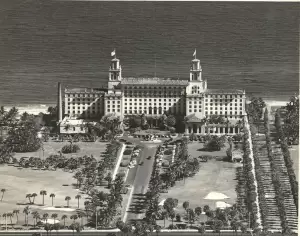
The war was especially visible to Palm Beachers after the War Department took over The Breakers hotel. From 1942 to 1944, the army operated The Breakers as the Ream General Hospital. It was first established to treat the expected high numbers of wounded from the allied invasion of North Africa. About 750 patients and 400 military staff lived under the command of the Medical Corps. Rich carpets and brocade hangings were removed, and some chandeliers were replaced with G-I lights. The south loggia of the hotel became an officers’ lounge, the ballroom became the recreation hall, the mezzanine turned into operating rooms, and the Cocoanut Grove room became a dental clinic. Officer patients enjoyed the view from rooms on the sixth and seventh floors and ate in the famous circular dining room. There was even a maternity ward. After the war, two Miami firms were hired to restore the hospital into the hotel, with John Volk of Palm Beach as architect-engineer.
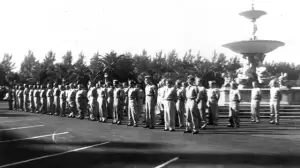
The Palm Beach Biltmore Hotel was also transformed into a U.S. Naval Special Hospital from mid-1945 to the end of the war, accommodating 1,400 soldiers convalescing from rheumatic fever or arthritis brought on by exposure. In June 1943, before it became a navy hospital, the Biltmore was used for the first dedicated school for the Coast Guard Women’s Reserve. SPARs, as it was known for its creed, “Semper Paratus, Always Ready,” was created by the U.S. legislature on November 23, 1942, to allow more men to be sent overseas. Until the Palm Beach school was ready, enlistees were trained on the campuses of Oklahoma A&M, Iowa State Teachers College, and Hunter College.
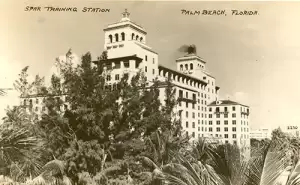
Male reservists spent a month converting 430 rooms in what was then reputed to be the most expensive building yet constructed in Florida. They replaced hotel furniture with “sturdy stuff” and knocked out walls to accommodate six women per room, removing doors and luxury decorations.
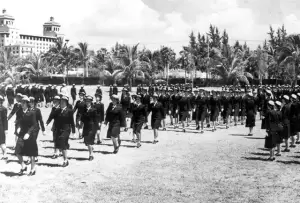
In December 1944, after more than 7,000 women had been trained in Palm Beach, SPARs recruitment effectively ended, and all future training was done at Manhattan Beach, New York.
Local Response: Palm Beach Hospitality
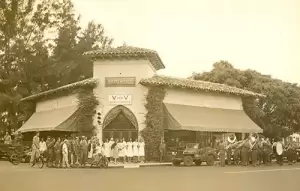
In 1942 the Miami News reported that Palm Beach had “turned the full power of its vast resources both of wealth and talent for war relief measures and civilian defense.” The Palm Beach Daily News similarly announced, “Debutantes and society matrons daily put in good hard backbreaking work in hospitals, motor corps and similar groups.” One such woman, Gloria Baker Topping, founded Aid America, Inc., which accomplished much of its fundraising with benefit events, such as setting vacationing professional baseball players against rookies from the Baseball College of America.
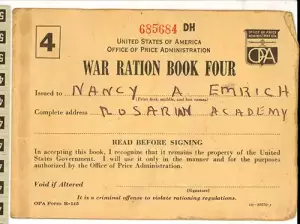
The Palm Beach Daily News insisted the locals emphasized “the sterner realities of war work” over entertaining servicemen. However, Sunday evening “at homes” for officers and their wives were held at the Society of Four Arts, and the Everglades Club entertained officers and enlisted men on alternating Monday evenings. Volunteers for Victory converted a grocery store into a soldiers’ canteen at 416 South County Road, Palm Beach, and operated a free bathhouse. A Servicemen’s Center went through 10,000 cookies each week.
In Palm Beach County as elsewhere, rationing applied to both rich and poor, although gasoline rations varied for necessary use. War Ration Book No. 1 was issued for sugar, and then Book No. 2 for coffee and canned goods. Each household was required to declare the quantity of coffee and canned or bottled goods in their possession in excess of the allowance of one pound of coffee per five weeks, and five cans per person. The War Price and Ration Board published instructions in the Palm Beach Daily News for registration on February 19, 1943, including how to register servants.

